Dr. Rubin: There were a lot more schools not nearly as many church congregations. That seems to have lost out to a lot of various ones of which I'm not at all familiar. Ours, I think is a dying proposition because we really only have a handful. I think maybe we have 10 members. According to Jewish custom you are supposed to have 10 male adults over the age of 13. Huh! Forget it.
(Laughter) We don't have 10 people even including little kids
Web: how often do they have services?
Dr. Rubin: we have services now once a month. We have a student rabbi come from the college in New York. We used to have regional one who was out of Cincinnati, the Hebrew Union College. Now they have a campus in New York, one in Los Angeles and they also have a campus in Jerusalem. First year students have to go to Israel for the first year.
At times we had services every two weeks. Now that's just once a month. Plus the holidays and holy days in the fall. We have had an occasionally steady rabbi who we had Friday night services.
When I was a child, does the name Bendheim Shoe Store mean anything to you?
Web: yes.
Dr. Rubin: that's where the outdoor Army store is. Mr. Gustave Bendheim, he was a father figure. He conducted services every Friday night.
Web: Are they the ones who lived down here on the corner?
Dr. Rubin: Yes they lived on the corner Monroe and fourth Street.

The Bendheim house, 401 West 4th Street. Originally a family by the name of Feldman lived there.
Dr. Rubin: Eve Vodrey sang in our choir. There was a Mrs. Rickersberg. They had a little store where the drugstore is that goes through, the one that goes from Market Street to Fifth Street, is that Bloors?
Web: Yes, Bloor's.
Dr. Rubin: okay, back then that was it, was an ice cream store. Flemings.
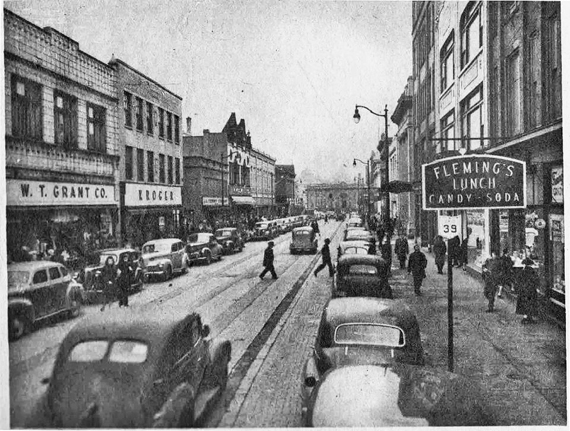
Dr. Rubin: She sang. She had a voice that pierced. (Laughter) We would never tell a student rabbi that. I think her husband sang in the choir too. They had a real honest to gosh organ. It has since been replaced with electric organ which hasn't been used either in years.
I was confirmed there when I was 16. Our congregation did not have the religious traditional Bar Mitzvah at the age of 13. In other congregations, that's when the traditional Jewish boys become adults at the age of 13 and there was a special service, all the boys had that.
The girls had nothing. Now they have something that instead of a Bar Mitzvah and I'm not sure what the bar means, they have what they call Bat Mitzvah for girls that age.
We had our congregation you were confirmed when you were 16. It was not a matter of becoming a man or an adult or anything it was a religious service.
When my father came to town in 1911, I have seen a picture of his store. His store was where the beauty shop is in the old Olgivie store, in the back there. That was a separate building, there were two entrances, one was my Dad's store on the corner of the Alley, and right next to that was a dress shop. That was it. I have seen pictures of that up to Fifth Street. There was a lot with a big iron fence around it. One of the Knowles families lived in there. I have seen the pictures from Broadway and Sixth Street so you just see the corner of it with the fence.
Web: You mean the house that was once there?
Dr. Rubin: Yes, the house. According to one of the women who worked for Dad, the daughters were not allowed to associate with the hoi polloi. (not sure of the word, but the meaning is clear)
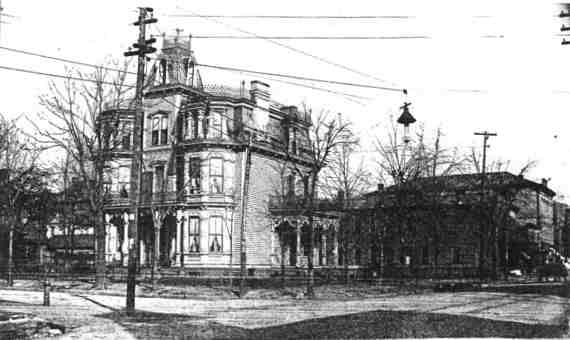
The Knowles House that sat where Olgivie's would eventually be built.
Dr. Rubin: At any rate, the main part of Olgivie's was built after 1911, I don't know the exact date.
Do you know the building across, on the corner where the drug store was?
Web: McBurney's Drug Store?
Dr. Rubin: Yes, do you know when that building was built?
Dr. Rubin: I was talking with Bob Johnson, that's the elevator man.
Web: It was before the Little Building but I don't know the date.
Dr Rubin: I was wondering because they look very similar, the bricks.
Web: The outside brick was same, yes, However, originally that building had a wooden exterior. The bricks were added later.
Dr. Rubin: Do you know if they were built by the same people?
Web: I don't know. We've have pictures before the Little building was there.
Dr. Rubin: What do your pictures show where the Little building is?
Web: A Clothing store.
Dr. Rubin: Was it a big building?
Web: No it wasn't tall like the Little Building.
Dr. Rubin: Cause Mr. Zack told me he has a picture that looks like a two or three story building was there before the Little Building.
Dr. Rubin: But there was something there?
Web: Yes, the clothing store and a drug store.
Sixth Street west from Diamond. Street at right foreground is Market. Dresden Ave. can be seen. The building on the near right is where Little Bldg now stands.
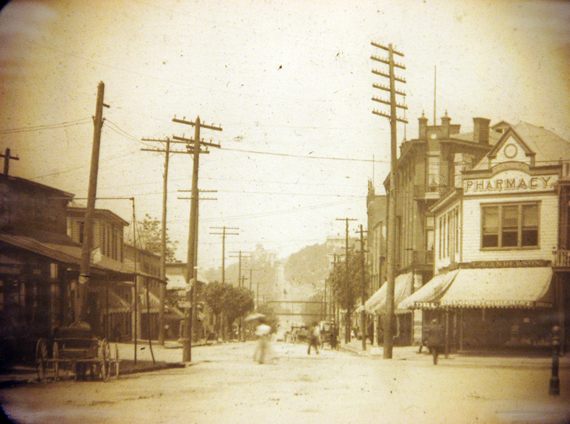
Diamond looking out Dresden Ave. Sixth Street Crossing from left to right. Notice the Pharmacy on the right. In time that building and the clothing stire beside it would be torn down and the Little Building would be built on that land.
Diamond Looking North out Dresden. Present site of Little Bldg. Notice that the builing on the left is the same building that will in time become McBurney Pharmacy. At this point in time the building has a wooden exterior.
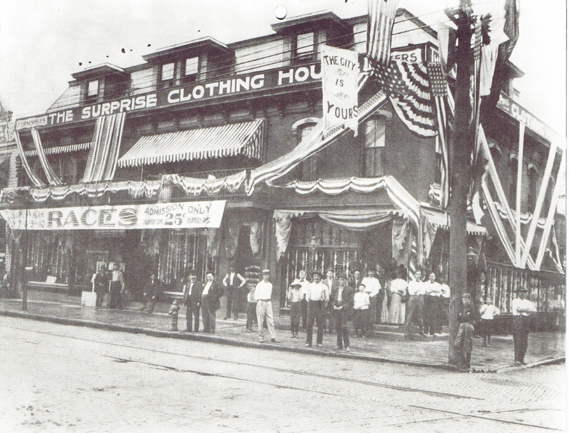
The Surprise Clothing House which formely stood at the site where the Little Building would be built in the early 1900s. Picture from 1999 Crockery City Calendar, Fourth Edition.

Dr. Rubin: I forgot to mention, Culligan still has place there. They use it just for storage. I was sorry to see Sherry close, you know Russell's. Mr. Bloomberg had it for a long time.
Web: It's a functional building. People could move into those offices. It not like some of the others that would have to be brought up to code.
Dr. Rubin: I wish they would, I would feel a lot safer. Newbolt has the idea of giving the thing up, but I hope he doesn't. I could never move my stuff out of there. There's just no way. I'd just have to close down and walk away.
There were a lot of doctors and dentists there.
There were a couple of sort of seedy hotels. There was one . . . Wasn't there a Ceramic Hotel some place up on Sixth?
Web: On the corner of Washington and Sixth, there was a hotel there at one time
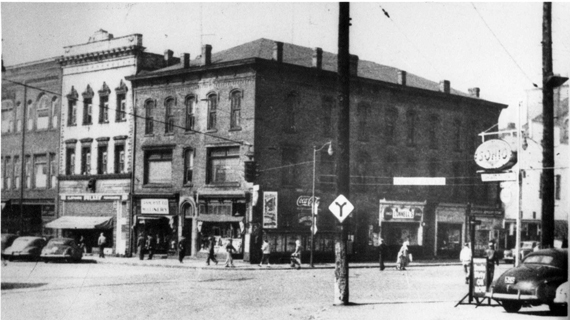
Grand Hotel, corner of Washington and 6th Streets.
and there was a hotel of course up from the High School on the corner there.
Dr. Rubin: Yea, I think that was the one I was thinking of. Then I think there was some kind of a dive down on Second Street next to the railroad station.
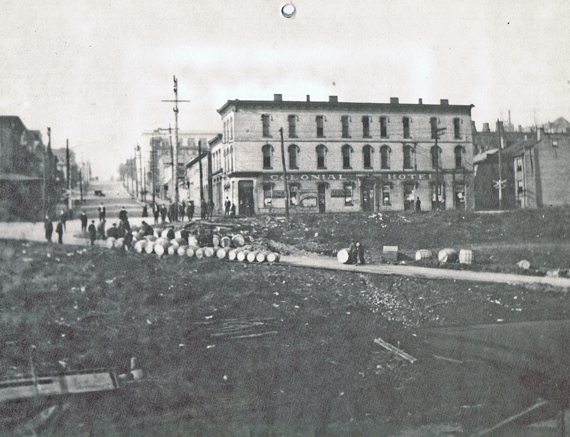
Some 2nd Street area hotels.
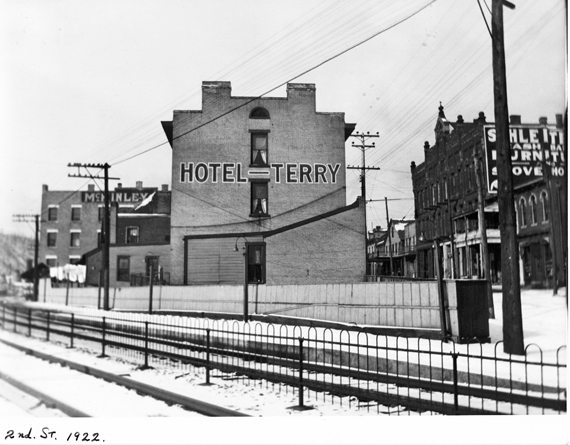
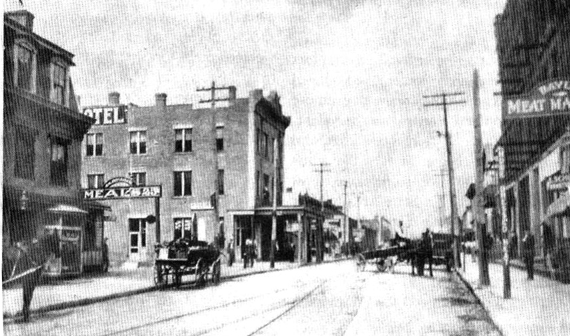
I have been told by people, that their grandparents used to wade across the river to get to work. Before the dams, most of the time they could do that up until the Spring rains came and it got up enough that they could get some kind of navigation. Somebody said at one time that C A Smith drove across somewhere up around Babb's Island.
I am amazed at time with the length of some of the tows that go up and down the river. I bet they are a block long. I'd like to drive down and watch them go through the locks. I have no idea how they do that. They would have to split them up. There was once a dam down by Wellsville. One up by Midland and another further up near Beaver?
Web: Yes.
Dr. Rubin: if you noticed in the paper yesterday there was a 99 year old man died who graduated 3 years before me. He would have been older than me if he had come to the old guard luncheon. I think there may be one or two older then that either in town or someplace around here that are not able to come to the luncheon. I was the oldest one at the old guard luncheon. Well I am planning , well not planning but aiming at 120 and when I get there I will figure out what I will do with the rest of my life. (Laughter)
In town, my father had a jewelry store on Washington Street. There was a Fredland's jewelry store, Maurice Fredland was my mother's brother. So he would have been my uncle. They had a store on the diamond. Leon Rubin, my father, trained Maurice, Jay and Isaac Fredland in the Jewelry buisnes. Reese's they were there next to the drug store in there someplace. Locke's, I don't how long they have been there.
Web: People's Drug Store was once on the corner of Market and Fifth.
Dr. Rubin: Yes they were, you're right.
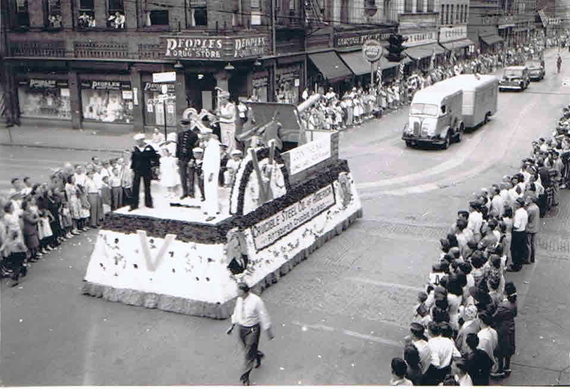
Dr. Rubin: And I remember Mrs. Fleming's. They had an ice cream parlor as they used to call it. Now I don't know whether they went through or if it went through [Through from E 5th to Market] after the drug store went in. They were on the Market street side.
Dr. Rubin: I can remember the tables with the little wires and the chairs, not wire exactly but like . .
Web: like wrought iron.
Dr. Rubin: Yeah, wrought iron, that's what I am trying to say. But that's where we went for ice cream, and you took the ice cream home.

Down on the corner of Fourth and Market, catty cornered from the Hot Dog Shoppe, I think Sayre Electric used to be there. Next to that I remember a Riggin's fish market. I remember that because my mother used to drag me in there every week when she would to go shopping. For some reason or other I have a memory that Friday was fish day. That's the day he got the fresh fish or something. It was on tables packed with ice. That's my memory of it. We always had fish on Friday, not because we were Catholic, but that's when you got the fresh fish. I used to dose up my fish with so much ketchup so I could eat it. Since we got on my own I haven't had fish since. I have these memories of these fresh fish, whole fish laid out on these beds of ice, Mother going in there, and he wrapped it up, I don't know in newspaper anyway they wrapped it up and we brought it home and fixed it. Anyway, that was next to not the corner but the next. It was on Market just up from the Sayre or whatever was there then.
The Olympic,. Where was that? That was an ice cream thing too, but not as high class as Flemings.
Web: I don't think it existed when I was around, but I have heard that it was beside the New York Restaurant on the Alley.
Dr. Rubin: Ok, OK, that was on St. Clair wasn't it?
Web: No that was on Market.
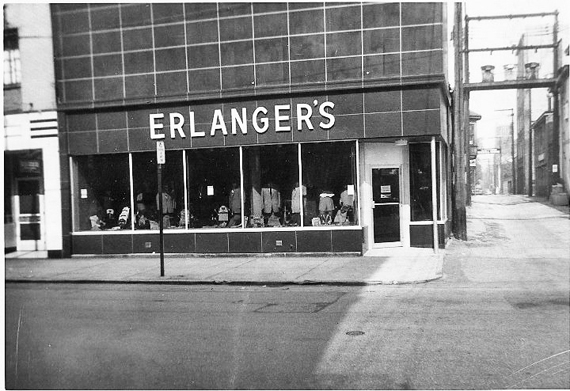
On this photo my grandmother noted this was where the Olympic was. Can someone share what the Olympic was? I'm guessing a restaurant maybe. I only knew this to be a fabric shop. . . Picture and text courtesy of Helen Pickering Doherty
Dr. Rubin: Oh, ok Market. So anyway the was the Olympic Confectioner, that was an ice cream place too. Bricker's was Isaly's. Across the alley from Brickers was the American Theatre. Across from the American Theatre was the Columbia Theatre. Next to the Columbia coming towards the Diamond there was a restaurant. I don't what it was before, but it became Newman's Grill. Mr. Newman had the dress shop next to my Dad's jewelry store. I don't know how it happened but he opened up a restaurant next to the Columbia Theatre. And next to that I had my office on the ground floor. After the war. My original office was in the back of my dad's store. That's what they did at that time. When I came home, he had sold the store to Jack Shaw, Shaw Jewelers. I didn't want to go in there. This building just wasn't clear back next to the restaurant. There were apartments up above that building. There was the theatre, then there was this building, then a stairway going up and my office was next to that. Next to that was Pattison's Jewelry. I can't remember what was on the corner.
Web: So when did you go into the Little Building?
Dr. Rubin: I think it was around, uh, I was in the building across from Bricker's and the building caught on fire. I didn't get burned out, I got drowned out. It was about 1980. I think I was in the Little building about 5 or 6 years then I retired. Well, I'm still there with my trains. I was looking up old records, and I last practiced there in 85. I think I was there about 5 or 6 years. That had been Dr. Birnbaum's or Dr. Grosser' or . . . I can't remember who else, there where I am now. Swearingin was across the hall on the corner. And there was Kinsey's, they called it Kinsey and the boys. New York Life was right across the hall from me in the front of the building. And Ben Feldman's. And of course, they have the office out on St Clair.
Web: Everybody moved out on St Clair.
Dr. Rubin: If half of them were still downtown, you'd have a thriving town. People tell me, I don't know, but they tell me that people are discouraging businesses from coming. Have you heard that?
Web: It's happened at times. But it is more complicated than that more often than not.
Dr. Rubin: I suppose but I just can't imagine why they seem to feel that way. Red tape or something puts up such blocks to new businesses coming in. I don't know.
Bill Bartolovich came to town because of me. Anyway, Bill came in, when he was visiting around and asked me what I thought about the town as a place for a practice and I thought he was very bright.
Dr. Rubin: Dr. Jackson, he was an optometrist. As you face the Little Building, on the corner. That's where Dr. Jackson was.. Coming this way from where the computer store is , the one that they call Dr. Computer, well an old optometrist was in there. He was ancient and I used I used to go "Oh my goodness, You know, WAIT! I'm going to be like that someday. (Laughter) Who'd want to go to an old man like that? I think I got out of it before I was that old. There was another Jewelry store. It had been there for a long time. On the corner there where the Dairy Land was. What do they call it now? Some kind of store. Was a clothing store, Robin and Sant, a men's clothing store. Ehrlangers was on the corner across from Olgivies. I worked in there on Saturday's as a kid when I was in school, dusting off the clothes and things. On Saturdays I had a job doing that.
Next to Ehrlangers was there was a men's store , but that was probably back before your day. and then there's a bank, There was always a bank there. There was a First National Bank, that is what I always remember there, then it became Bank One, then Chase.
I remember it as a bank and every few days we had to make a deposit for the jewelry store. And I remember being in there. Tom Fisher was, oh he was an old man. I know he was the president of the bank.
My daughter-in-law wanted to have a birthday party for me when I was ninety. I said no, let's wait until I am a hundred. Ever since then, I have been inviting people to my hundredth birthday. If everybody comes who says they're going to come, we're going to have to have it in the stadium. There'll be a cake with a hundred candles and the fire engine standing by. We were talking the other night though at this one year old's party that the best way to do that would be just to spell out one hundred rather than try to light a hundred candles. . . . .But the 120th , maybe out of reach, but maybe not. Maybe I'll make it or maybe not. Wait a minute somebody I was talking to someone the other day, somebody's mother or grandmother was a hundred and seven. Really, how'd they do it. But it happens.
I get a little uneasy particularly when I see somebody my age in the obituaries, realizing that I'm up there too. But what the heck, I mean I'm ready, anytime I'm ready. If somebody told me that tomorrow was going to be the day, I wouldn't be, I mean I wouldn't worry about it. I mean that there's nothing that I really want to do that I would really miss doing, couldn't do it anyway. I figure I drive, most days I drive 1 mile. It's one mile round trip to the Little Building. So in a week, I drive 5 miles. Once in a while, I'll drive out to Chase Bank. But that's about the extent of my driving.
Dr. Rubin: That Dick Martin that I mentioned, he's fifteen years younger, he used to work at the power company. He's been driving to Morgantown and I drive and I take his wife shopping. I drive and pick her up. I drive to Giant Eagle every Wednesday morning so I do drive that far. . If I couldn't drive, that would be very bad.
Dr. Rubin: What else do you want me to tell you? Any subject you want talk about. I did mention the railroad, the passenger trains.
I remember truck gardens, is that what they called them? A lot of people had garden down there, They had gardens down in the area near Patterson Field. People used to grow vegetables down there.
Web: I have always heard that where Westgate is built that is was once a garbage dump but I have never found any pictures so far that shows that area as a garbage dump.
Dr. Rubin: Yes, yes, they did haul garbage down there. I don't remember the exact time but they did haul garbage down there. I don't remember when they built Patterson Field. I do remember wooden bleachers but not when they built the other stands. I was in the band, so I do remember the wooden stands.
I remember a recent Memorial Day Parade and I was thinking, Eighty years ago I would have been in the band in that parade. You know that is forever, that eighty years. I remember, we didn't have uniforms like they have now. We had White pants and my mother sewed a blue stripe down the side and of course the first time they got washed, the blue didn't fade onto the white but the blue changed colors. There was a cape with a blue outside and a white lining and whatever they called the hat. That was our uniform. We wore a white shirt with the white pants. I think my last year, if I am not mistaken, we did have regular uniforms.
I remember the street cars but I don't really remember the buses very much. I guess by the time the buses came along I didn't ride them. But they did have the city buses . I had forgotten they did have a street car line up Lisbon Street up to Pleasant Heights. It went up, I think it went up the hill if I am not mistaken.
I don't remember if there was a line going out , there must have been a line going out Dresden, out California Hollow.
Web: Yes there was.
I was away from 1943 to 46. I was lucky. They sent me to California, I was in the medical Division. I got my basic Training in Salt Lake City then they sent me out to Santa Monica. I never went overseas.
This site is the property of the East Liverpool Historical Society.
Regular linking, i.e. providing the URL of the East Liverpool Historical Society web site for viewers to click on and be taken to the East Liverpool Historical Society entry portal or to any specific article on the website is legally permitted.
Hyperlinking, or as it is also called framing, without permission is not permitted.
Legally speaking framing is still in a murky area of the law
though there have been court cases in which framing has been seen as violation of copyright law. Many cases that were taken to court ended up settling out-of-court with the one doing the framing agreeing to cease framing and to just use a regular link to the other site.
The East Liverpool Historical Society pays fees to keep their site online. A person framing the Society site is effectively presenting the entire East Liverpool Historical Society web site as his own site and doing it at no cost to himself, i.e. stealing the site.
The East Liverpool Historical Society reserves the right to charge such an individual a fee for the use of the Society’s material.